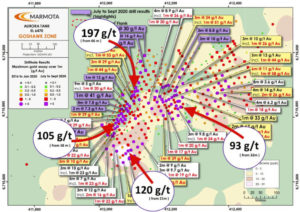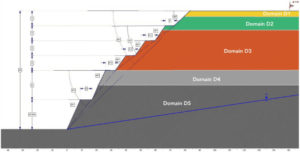Aurora Tank pit wall design takes Marmota closer to touching gold
Mining
Mining
Marmota is another step closer to producing gold from Aurora Tank after receiving the first realistic pit wall parameters for an open pit at the project.
The pit design was carried out by geotechnical engineering consultancy Rocktest, which based it on analysis and testing of diamond core obtained from the company’s recent diamond drilling program.
Encouragingly, Rocktest has identified five geological domains that do not vary much across the site – a result that simplifies the design of the pit.
Marmota (ASX:MEU) is understandably keen to get Aurora Tank off given the consistent close to surface, high-grade gold hits that it has recorded over the course of the last nine drill programs, all of which have returned outstanding high-grade intersections.
Bulk Leach Extractable Gold (BLEG) analysis has also returned even higher-grade results than the original drill sampling, including over 200 g/t gold over 1m, while negating the “nugget effect” that can skew results in either direction due to its use of larger samples.

“Marmota is delighted to tick off another box to progress Aurora Tank from discovery to production by low-cost low-capex open-pittable mining including using heap leach methods,” executive chairman Dr Colin Rose says.
“Moreover, these geotechnical results themselves are very pleasing as they have significantly improved upon the conservative assumptions for pit wall design assumed to date.
“Our substantive flora and fauna environmental studies for Aurora Tank are already completed. Our BLEG testwork in February yielded our highest assays ever, with grades over 200 g/t gold over 1m.
“We are now about to commence final stage metallurgical testing and design for optimal heap leach recoveries at a specialist lab in Sydney.”
Aurora Tank is hosted in Christie Gneiss, a metamorphic rock that has undergone lower temperature metamorphism that has left mineral grains oriented in such a way that the rock is easily split into thin flakes or plates.
This layering results in the rock being significantly stronger perpendicular to the foliation than along the foliation.
Engineering characteristics of the Gneiss vary significantly with weathering grade with the weathering in the upper part resulting in these rocks displaying soil like characteristics, whereas in the less weathered and fresh rock zones, the areal extent and frequency of structural discontinuities such as joints and faults will have the greatest influence on rock mass stability.

Groundwater level is assumed to be about 70m below ground level, so pit walls in Domains D1 to D3 are expected to be dry while local sumps in the floor of the pit are expected to be required in domains D4 and D5.
Rocktest recommended that access to the pit be developed by means of a clockwise spiral ramp from the NW corner of the pit.
This article was developed in collaboration with Marmota, a Stockhead advertiser at the time of publishing.
This article does not constitute financial product advice. You should consider obtaining independent advice before making any financial decisions.